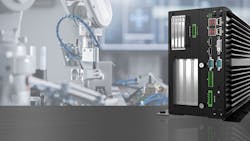Industrial Computers: Built Rugged, Built Ready for Machine Vision
Quality control has been identified as one of the primary bottlenecks in production due to its criticality and timely nature. With machine vision, IoT devices and machine vision systems work in tandem to automate QC processes at superhuman accuracy and speed. However, this innovative technology requires a high-performance edge computing solution to reliably power the complex and latency-sensitive AI workloads. Enter Premio’s VCO-6000-RPL Machine Vision Computer, an industrial computer purpose-built with key hardware technologies to streamline machine vision applications with hardened reliability.
Explore our latest Machine Vision Computer (VCO-6000-RPL) >>
Hardware Technologies For Machine Vision Applications
Heterogenous computing within Premio's Machine Vision Computers are the main drivers of machine vision. By combining meticulously selected components, edge computing manufacturers like Premio Inc. can construct a system specifically optimized for machine vision applications. Each component is required to meet some level of industrial-grade reliability and performance for these complex edge vision AI workloads.
Specialized Hardware Accelerators For Machine Vision:
• CPU: sequential processing for task management and single-threaded workloads. Semiconductor manufacturers have developed specific CPU models that have been tailored to embedded deployments. These embedded models leverage highperformance at low TDP and have extended product lifecycle management.
• GPU: the powerhouse for complex machine learning workloads with parallel processing. Workstation-class GPUs have been designed for edge AI acceleration with emphasis on performance in TOPS and stabilized driver roadmaps.
• TPU: designed to process lite AI inferencing workloads in an ultra-compact m.2 form factor with minimal power consumption. Ideal for enabling AI workloads in space-constrained deployments.
• NPU: integrated AI acceleration at the microprocessor level. Semiconductor manufacturers have recognized the significance of machine learning and have implemented a dedicated low-power AI engine within their processors.
PCIe 4.0 For GPU Support, High-Speed I/O, and Flexible Expansion
PCIe 4.0 plays a vital role for Machine Vision Computers in powering and enabling machine vision applications. By delivering theoretical data throughputs of 16 GT/s (or 2GB/s), PCIe 4.0 has allowed various components to synergize and work cohesively to drive complex machine vision AI workloads in real-time.
PCIe architecture is directly linked to heterogenous computing because it provides the capabilities to incorporate core hardware accelerators into the system. These hardware accelerators such as GPUs and add-on expansion cards leverage PCIe performance to process vast amounts of data with minimal latency.
Importance Of Memory (RAM)
High-speed memory, or RAM, is needed to enable real-time processing for machine vision applications. Memory temporarily stores large volumes of data for immediate access and usage. Machine Vision Computers utilize DDR SODIMM memory for enhanced ruggedness and allow for a compact footprint. In some industrial computers, ECC memory is supported for extended operational reliability; prolonging uptimes and reducing possibilities of system failure.
Connectivity For IoT Sensors and Cameras
I/O connectivity is critical to driving machine vision applications and is often overlooked.
Machine Vision Computers are designed to provide compatible I/O for IoT cameras and sensors to connect and seamlessly process the raw data for real-time insights. USB and GigE are common vision camera interfaces that offer an optimized balance between:
• Bandwidth speed
• High-resolution imagery
• Framerate
• PoE Support
• Cable length reliability
These connection interface features are vital to the overall performance and reliability of relaying quality data for AI analysis. Since machine vision systems vary in deployment specifications, it is important for the industrial computer to offer flexibility to meet all sorts of I/O configurations. Whether it be PoE support, M12 connection types, USB 3.2 (10 Gbps) ports or even high-speed networking, Machine Vision Computers should have the flexibility to meet those requirements through either fixed on-board I/O or Premio’s EDGEBoost I/O modules.
Digital I/O For Smart Programmable Automation
A unique feature of Machine Vision Computers is the inclusion of GPIO or DIO ports. It provides system integrators and OEM designers with greater flexibility and customization for their automation applications. DIO ports can be utilized to monitor the status of specific devices, communicate with electronic instruments, and control actuators, switches, etc.
Tested Reliability & Validated Compliance
Since fans are a common failure point in industrial computing, Premio’s Machine Vision Computers take a fanless and cableless approach to significantly reduce the risks of system failure while in operation. It also provides critical benefits with:
- Wide operating temperatures
- Shock and vibration resistance
- Prevents cabling failure
- Eliminates internal accumulation of dust and debris
As an added layer of assurance and peace of mind, these industrial computers have been rigorously tested and validated to achieve CE, FCC, and UL Listed certifications for safety standard compliance.
Machine Vision Computer (VCO-6000-RPL Series)
The VCO-6000-RPL incorporates all the hardware technologies necessary to streamline complex machine vision applications in real-time. From a fanless architecture for rugged reliability to PCIe 4.0 expansion for dual-GPU support, it is Built Rugged, Built Ready for edge AI deployments.
- 13th Gen Intel Core Processor
- Dual GPU Support (FHFL)
- 4x Hot-swappable NVMe SSD Bays
- Isolated DIO (8 in/8 out)
- USB & GigE Vision Ready
Discover Machine Vision Computer (VCO-6000-RPL Series) >>

